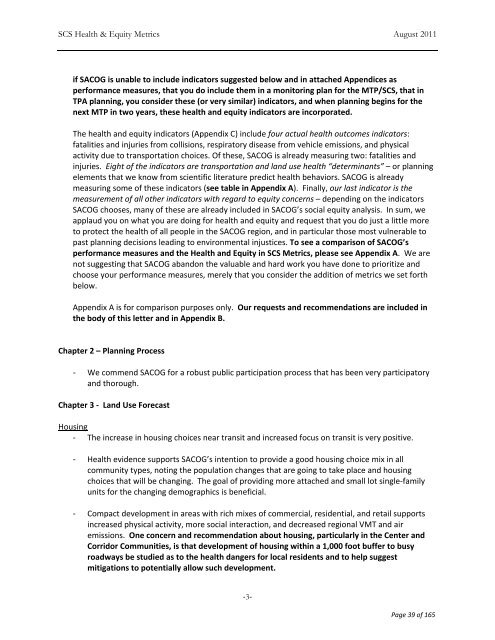Draft MTP/SCS Comments Received - sacog
Draft MTP/SCS Comments Received - sacog
Draft MTP/SCS Comments Received - sacog
You also want an ePaper? Increase the reach of your titles
YUMPU automatically turns print PDFs into web optimized ePapers that Google loves.
<strong>SCS</strong> Health & Equity Metrics August 2011<br />
if SACOG is unable to include indicators suggested below and in attached Appendices as<br />
performance measures, that you do include them in a monitoring plan for the <strong>MTP</strong>/<strong>SCS</strong>, that in<br />
TPA planning, you consider these (or very similar) indicators, and when planning begins for the<br />
next <strong>MTP</strong> in two years, these health and equity indicators are incorporated.<br />
The health and equity indicators (Appendix C) include four actual health outcomes indicators:<br />
fatalities and injuries from collisions, respiratory disease from vehicle emissions, and physical<br />
activity due to transportation choices. Of these, SACOG is already measuring two: fatalities and<br />
injuries. Eight of the indicators are transportation and land use health “determinants” – or planning<br />
elements that we know from scientific literature predict health behaviors. SACOG is already<br />
measuring some of these indicators (see table in Appendix A). Finally, our last indicator is the<br />
measurement of all other indicators with regard to equity concerns – depending on the indicators<br />
SACOG chooses, many of these are already included in SACOG’s social equity analysis. In sum, we<br />
applaud you on what you are doing for health and equity and request that you do just a little more<br />
to protect the health of all people in the SACOG region, and in particular those most vulnerable to<br />
past planning decisions leading to environmental injustices. To see a comparison of SACOG’s<br />
performance measures and the Health and Equity in <strong>SCS</strong> Metrics, please see Appendix A. We are<br />
not suggesting that SACOG abandon the valuable and hard work you have done to prioritize and<br />
choose your performance measures, merely that you consider the addition of metrics we set forth<br />
below.<br />
Appendix A is for comparison purposes only. Our requests and recommendations are included in<br />
the body of this letter and in Appendix B.<br />
Chapter 2 – Planning Process<br />
‐ We commend SACOG for a robust public participation process that has been very participatory<br />
and thorough.<br />
Chapter 3 ‐ Land Use Forecast<br />
Housing<br />
‐ The increase in housing choices near transit and increased focus on transit is very positive.<br />
‐ Health evidence supports SACOG’s intention to provide a good housing choice mix in all<br />
community types, noting the population changes that are going to take place and housing<br />
choices that will be changing. The goal of providing more attached and small lot single‐family<br />
units for the changing demographics is beneficial.<br />
‐ Compact development in areas with rich mixes of commercial, residential, and retail supports<br />
increased physical activity, more social interaction, and decreased regional VMT and air<br />
emissions. One concern and recommendation about housing, particularly in the Center and<br />
Corridor Communities, is that development of housing within a 1,000 foot buffer to busy<br />
roadways be studied as to the health dangers for local residents and to help suggest<br />
mitigations to potentially allow such development.<br />
‐3‐<br />
Page 39 of 165
















